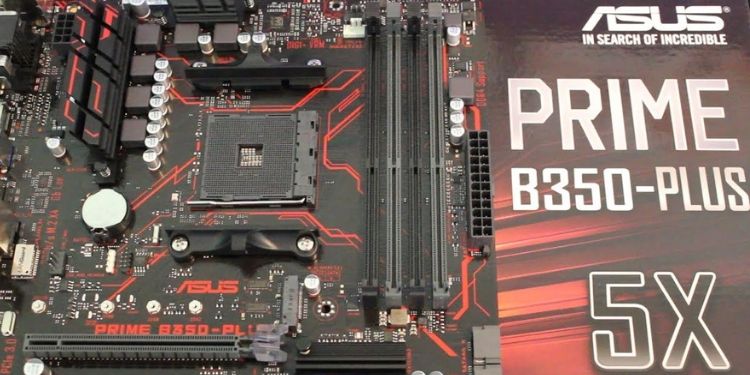Last Updated on
If you’re in the market for a new gaming motherboard, especially if you’re on a tight budget, an AMD B350 motherboard is probably a good option. They’re cheap, reliable, and cost-effective, all of which are important when you’re trying to get the best bang for your PC gaming buck.
AMD B350 motherboards are great because they’re compatible with AMD’s Ryzen CPUs, and they support overclocking as well. You can usually find a pretty good B350 motherboard for less than $100, which is awesome for budget builders. In short, if you’re looking to run a budget build, then these are some of the best Ryzen motherboards. In this guide, we’re going to take a look at the best B350 motherboards of 2019.
Buyer’s Guide: How to Pick The Best B350 Motherboard on a Budget
When you’re building a budget gaming PC, choosing an AMD B350 motherboard is probably your best bet. Why?
Well, for starters, AMD CPUs tend to have a better bang for your PC gaming buck, as opposed to Intel CPUs which are disproportionately more expensive. AMD B350 motherboards are, aside from cheap and reliable, capable of overclocking.
You won’t be able to achieve any insane overclocks with a B350 motherboard, mind you, but they’ll definitely get the job done, especially if you’re building on a budget. For example, I managed to overclock my Ryzen 3 1200– a budget gaming CPU– to a stable 4.0GHz with the stock cooler and an AMD B350 motherboard.
Form Factor
If you’re buying a new motherboard, its form factor should be one of the first things you think about. Motherboards come in many different form factors, the three most popular of which are ATX, Micro-ATX, and Mini-ITX.
- ATX boards are the largest, and they usually have more features and ports to offer than their counterparts. As a consequence, they also tend to be more expensive.
- Micro-ATX boards are kind of like a crossover between the popular ATX and Mini-ITX form factors. They’ll definitely have fewer features to offer than a full-sized ATX board, but they’ll still get the job done. They’re cheap, which is great for a budget.
Mini-ITX boards are also pretty awesome, but they’re not always as cheap as you might think. Since they’re so small, they’re usually meant for Mini-ITX cases as well, which are more expensive thanks to their smaller, more convenient sizes.
Socket Type
Your motherboard’s socket type is incredibly important. The socket type determines which CPUs are going to be compatible with your board.
By the way, we’re not just talking about Intel versus AMD CPUs here– both brands have different CPUs with different socket types, which are usually specific to a family or generation of CPUs.
For example, many of Intel’s most recent CPUs use the LGA 1151 socket type, whereas AMD’s Ryzen CPUs– the only AMD CPUs you should be messing with nowadays– sport the AM4 socket.
Chipset
Your motherboard’s chipset is also important to consider. If your motherboard socket type is compatible with your CPU, that still doesn’t necessarily guarantee chipset compatibility.
For example, some older chipsets may have outdated BIOS that need to be updated before they’re compatible with a newer CPU. This can be an issue if you don’t have another CPU to use for the BIOS update, as you won’t be able to update your BIOS with the new CPU.
You’re also going to need the right chipset if you plan on overclocking, as not all chipsets support overclocking. Moreover, some chipsets cater to overclocking better than others, so it’s really all about picking the right one for the job. This is going to be dependent on your budget and your objectives for your build.
RAM Compatibility
If you’re using an AMD B350 chipset, you’ll have to use DDR4 memory. Otherwise, older CPUs are only going to be compatible with DDR3 memory.
AMD Ryzen CPUs see a significant performance boost when coupled with high-speed RAM, so you’ll probably want to go for DDR4-2400 at the minimum. When you’re thinking about motherboard compatibility, it’s important to look at how many RAM slots your motherboard has, what type of RAM it supports, and what speeds it supports.
If you only have two DIMM slots, you might want to get at least 2x4GB of RAM.
Storage Support
It’s important to consider how many SATA ports your motherboard has, as this will determine the number of storage drives you can have. You also may want to consider M.2 slots, as this is going to be important if you want M.2 or NVME drives in your gaming PC.
PCIe Slots
Depending on your usage, you’ll want a varying number of PCIe slots. For just a barebones set-up, you’ll only need one x16 slot for your graphics cards. However, gamers looking to upgrade their rig with GPU’s in Crossfire or SLI will need one x16 slot for each card.
PCIe x1 slots can be used to install sound cards, video capture cards, tv tuners, network cards, and a variety of other add-ons. If you plan to make a lot of future upgrades and additions, be sure to choose a motherboard with enough slots.


